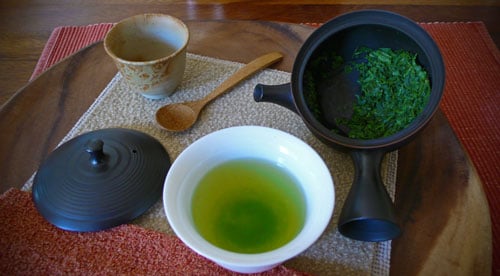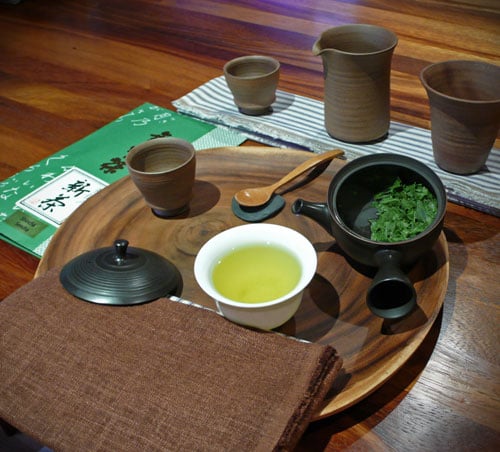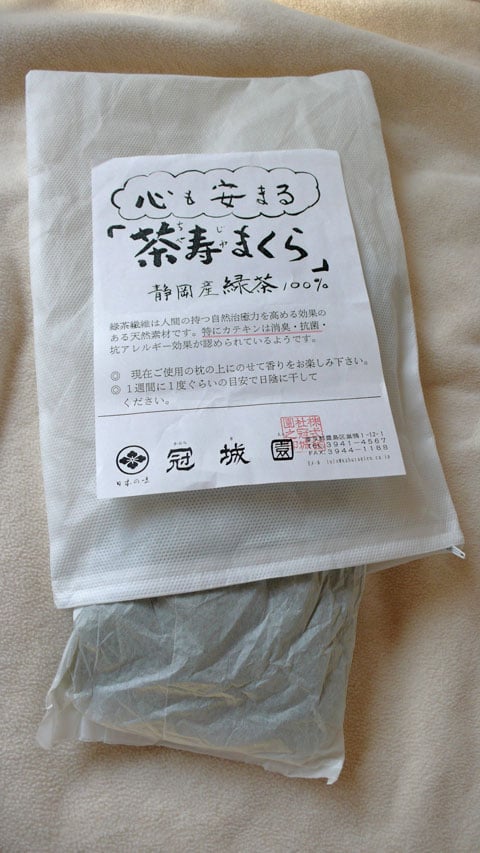Page 1 of 3
Official Shincha 2013 Review Topic
Posted: May 5th, '13, 12:16
by Chip
Today is May 5th ... should we designate this
Happy Shincha de Mayo?

Too bad I missed posting this topic on May 2nd, which was
Hachiju-Hachiya, the traditional 88 Nights, when traditional Hachiju-Hachiya is picked.
Anyway, I digress.
This is the official Shincha review topic for 2013 harvest. Please post your comments, reviews, discussions, questions on this year's Shincha.
Re: Official Shincha 2013 Review Topic
Posted: May 5th, '13, 12:19
by victoria3
Perfect I was just wondering if this would be set up. Excellent.
Re: Official Shincha 2013 Review Topic
Posted: May 6th, '13, 21:12
by victoria3
I decided to start the sincha de mayo fest with the ‘First Pick Tea’ of the year as it arrived early in the mail,
Maeda-en’s 2013 Shin-cha Oohashiri. It is the earliest tea harvest of the year, as opposed to 88 nights, and wow this is one rich taste experience! pow.
The dry leaves are deep green, rolled finely and have a fresh lyrical grassy sweet aroma. The liquor is a beautiful vibrant green and has lovely smooth sweet rounded flavors. The flavor is vegetal, but not grassy cheap, and has a sweet aroma like flowers, spring is in the air. Very green smooth sweetness, with nuttiness, and floral aroma. A rich palate.
Steep parameters: 1st/2nd/3rd/4th
4gr/4oz/160F/55sec, /170F/90sec, /180F/2min, transferred to stove top for a 5sec roll boil/steep 2 min.

- Maeda-en-2013-Shin-cha-Oohashiri-(The-First-Pick)_.jpg (27.32 KiB) Viewed 10930 times
This is one rich sincha that is well worth a sit down moment to properly experience. So far this one is a stellar pick and I look forward to comparing it with other 2013 sinchas.
p.s. this wide mouthed kyusu, by Gyokuryu, with a very large sasame filter, makes a nice quick pour of this young sincha. 3/4 of the way through a pour I swing the kyusu and give it a quick tap to move leaves away from the filter. Works well especially since the kyusu is so light.
Re: Official Shincha 2013 Review Topic
Posted: May 7th, '13, 00:22
by victoria3
Today I opened up another first harvest tea,
Maiko’s Sincha Sencha. This more subtle asamushi sincha transported my sense to the seashore, with fishing boats and seagulls coming and going. Dry leaf is compactly rolled with a slight sweet nutty aroma. The liquor is clear with a more muted tones of yellow beige green. The liquor is lighter than Maeda-en’s Shin-cha Oohashiri imparting a very difference seaside sensory experience. A well balanced, sweet vegetal astringency, with smooth rich overtones and seaweed background. It is not delicate yet not overly bold either. A very well priced flavor experience.
Steep parameters: 1st/2nd/3rd/4th
4.4gr/4oz/160F/60sec, /175F/90sec, /185F/2min, transferred to stove top for a 5sec roll boil/steep 2 min.

- Maiko-2013-Sincha-Sencha.jpg (48.28 KiB) Viewed 10910 times
In rear is a Tokoname sake set by Hokujo from Artistic Nipon which I am using instead as a water cooler and tea cups. Rear right a bizen tea mug for larger steeps.
Re: Official Shincha 2013 Review Topic
Posted: May 8th, '13, 02:05
by ntan1
I've had two-three independent trials of the Kinari from Maiko this year so far. My gut feeling is that the first steeping is extremely sweet, and a bit more delicate than 2012. While in the past, the first steeping was extremely full-bodied and complex, I'm getting even more interesting flavors in the second steeping this year.
Standard directions, 60-70C for 1:30. I may try to raise the temperature a tiny bit or add a little bit of leaf to see what comes out.
Re: Official Shincha 2013 Review Topic
Posted: May 8th, '13, 11:30
by victoria3
ntan1 wrote:.. Kinari from Maiko ....... While in the past, the first steeping was extremely full-bodied and complex, I'm getting even more interesting flavors in the second steeping this year.
Standard directions, 60-70C for 1:30. I may try to raise the temperature a tiny bit or add a little bit of leaf to see what comes out.
ntan1 how much leaf to water did you use for the Kinari? Maiko's Kinari is one of my favorites.
Re: Official Shincha 2013 Review Topic
Posted: May 8th, '13, 13:08
by ntan1
victoria3 wrote:
ntan1 how much leaf to water did you use for the Kinari? Maiko's Kinari is one of my favorites.
8g, 5/4 cup of water.
Re: Official Shincha 2013 Review Topic
Posted: May 8th, '13, 13:25
by Chip
ntan1 wrote:victoria3 wrote:
ntan1 how much leaf to water did you use for the Kinari? Maiko's Kinari is one of my favorites.
8g, 5/4 cup of water.
Define cup please? 6 ounces, 8 ounces? Other?
Re: Official Shincha 2013 Review Topic
Posted: May 8th, '13, 21:09
by victoria3
Did I mention that Kaburagien threw in a Green Tea Pillow made of fresh tea as a 2013 sincha pre-order thank you gift. Very nice indeed, it has a really smooth warm and fuzzy scent of fresh green tea. Apparently sleeping on tealeaves helps one fall asleep, soothes headaches, and reduces stress. In my case, after a few days of tasting a few of my new sinchas and then sleeping with fresh tea, I think I got sincha-loaded. To compensate, today I switched to O-Cha’s Uji Sencha Otsuusan


- Kaburagien-Tea-Pillow.jpg (70.97 KiB) Viewed 10706 times
Re: Official Shincha 2013 Review Topic
Posted: May 8th, '13, 22:10
by ntan1
Chip wrote:
Define cup please? 6 ounces, 8 ounces? Other?
300ml total in 5/4 cup. Generally when people use 'cup', they are referring to either the American standard or metric standard, which have a very small difference (in this context).
Re: Official Shincha 2013 Review Topic
Posted: May 8th, '13, 22:21
by Chip
ntan1 wrote:Chip wrote:
Define cup please? 6 ounces, 8 ounces? Other?
300ml total in 5/4 cup. Generally when people use 'cup', they are referring to either the American standard or metric standard, which have a very small difference (in this context).
(please understand, since you are new to TeaChat, we have little or no reference as to where you are in experience. So, please do not take offense. Also since you are new here, perhaps our lingo is not quite in sync yet)
Just so I am understanding, you are brewing 8 grams in 300 ml?
I generally start at 1:1, meaning 1 gram per 1 ounce (30 ml). Upon first trial, I either keep it at 1:1 or generally increase the ratio of leaf to water as needed. I notice you are well below 1:1.
Just a suggestion, you could do smaller steeps using a higher ratio to achieve a more robust brew.
Of course adjusting temp is another route to take.
I should have Kinari in a few days time.

Re: Official Shincha 2013 Review Topic
Posted: May 8th, '13, 22:34
by ntan1
Yes, I tend go for a slightly lower than 1:1 ratio and increase from there, and have done it with most asamushi's. This has turned out to mostly be a thing of preference (and I understand that it varies from person to person).
Re: Official Shincha 2013 Review Topic
Posted: May 9th, '13, 01:10
by victoria3
ntan1, yes some do prefer lighter brews or less than 1:1, although I also start with 1:1 ratio. I'm also looking forward to trying 2013 Kinari in the coming week and will then post brew paramaters that work best for me. A useful and common language for sharing our steeping parameters is;
Grams leaf/Ounces water/Centigrade or Fahrenheit temp/Seconds or Minutes steep time.
Another thought; does anyone notice that Sincha's are more fragile and prone to quicker oxidation in general? i.e. once a tea bag is opened it oxidizes faster than sencha or gyokuro? It seems the taste changes more quickly once opened.
Re: Official Shincha 2013 Review Topic
Posted: May 9th, '13, 02:04
by Poohblah
victoria3 wrote:Another thought; does anyone notice that Sincha's are more fragile and prone to quicker oxidation in general? i.e. once a tea bag is opened it oxidizes faster than sencha or gyokuro? It seems the taste changes more quickly once opened.
I have been under the impression that this is because sencha sold as shincha often has undergone less processing than regular sencha.
Re: Official Shincha 2013 Review Topic
Posted: May 9th, '13, 03:25
by victoria3
Poohblah wrote:victoria3 wrote:Another thought; does anyone notice that Sincha's are more fragile and prone to quicker oxidation in general? i.e. once a tea bag is opened it oxidizes faster than sencha or gyokuro? It seems the taste changes more quickly once opened.
I have been under the impression that this is because sencha sold as shincha often has undergone less processing than regular sencha.
Well for sure these young sincha leaves are the most tender, being the first flush new crop harvest (Ichibancha). Since these leaves are so young and tender, therefore thin skinned, it would make sense to me that they are more prone to quickly oxidize. (Gyokuro is also first flush but then goes through a settling period of several months during which time some sort of biological process occurs which sweetens the dry leaf further)
Some Factors that lead to Different Types of Sincha
Cultivar & Regional differences.
Harvest Time: Oohashiri, Hatsuzumi, is the first harvest of the year followed by 88th Night.
Picking: Hand plucked versus machine cut.
Shading & Steaming:
Sincha Asamushi, 35-40 sec. light steamed
Sincha Gyokuro, shade grown 10-14 days? (versus Gyokuro shaded 3 weeks-90 days?) & medium steamed- Chumushi ?
Sincha Fukamushi, up to 1.5 min deep steamed
Kneading, Shaping, Drying: Hand versus machine kneaded +- 1.5 hours, shaped +- 1 hour, and dried +- 1 hour.
Sorting & Re-Drying: Tea leaves, stems, veins are separated, and moisture content reduced to 3-4%
This is only a partial running list that I’ve put together so please add to it, comment on it and or amend it.
 Too bad I missed posting this topic on May 2nd, which was Hachiju-Hachiya, the traditional 88 Nights, when traditional Hachiju-Hachiya is picked.
Too bad I missed posting this topic on May 2nd, which was Hachiju-Hachiya, the traditional 88 Nights, when traditional Hachiju-Hachiya is picked.